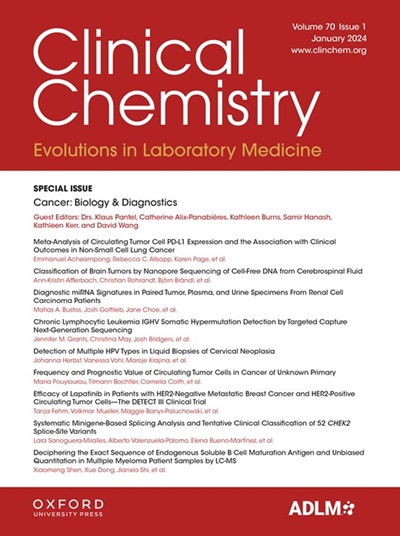MIQE 2.0: Revision of the Minimum Information for Publication of Quantitative Real-Time PCR Experiments Guidelines.
IF 7.1
2区 医学
Q1 MEDICAL LABORATORY TECHNOLOGY
引用次数: 0
Abstract
BACKGROUND In 2009, the Minimum Information for Publication of Quantitative Real-Time PCR Experiments (MIQE) guidelines established standards for the design, execution, and reporting of quantitative PCR (qPCR) in research. The expansion of qPCR into numerous new domains has driven the development of new reagents, methods, consumables, and instruments, requiring revisions to best practices that are tailored to the evolving complexities of contemporary qPCR applications. CONTENT Transparent, clear, and comprehensive description and reporting of all experimental details are necessary to ensure the repeatability and reproducibility of qPCR results. These revised MIQE guidelines reflect recent advances in qPCR technology, offering clear recommendations for sample handling, assay design, and validation, along with guidance on qPCR data analysis. Instrument manufacturers are encouraged to enable the export of raw data to facilitate thorough analyses and re-evaluation by manuscript reviewers and interested researchers. The guidelines emphasize that quantification cycle (Cq) values should be converted into efficiency-corrected target quantities and reported with prediction intervals, along with detection limits and dynamic ranges for each target, based on the chosen quantification method. Additionally, best practices for normalization and quality control are outlined and reporting requirements have been clarified and streamlined. The aim is to encourage researchers to provide all necessary information without undue burden, thereby promoting more rigorous and reproducible qPCR research. SUMMARY Building on the collaborative efforts of an international team of researchers, we present updates, simplifications, and new recommendations to the original MIQE guidelines, designed to maintain their relevance and applicability in the context of emerging technologies and evolving qPCR applications.MIQE 2.0:修订实时定量PCR实验指南出版的最低信息。
2009年,定量实时PCR实验(MIQE)指南建立了定量PCR (qPCR)研究的设计、执行和报告标准。qPCR扩展到许多新领域,推动了新试剂、新方法、新耗材和新仪器的开发,需要对最佳实践进行修订,以适应当代qPCR应用的不断发展的复杂性。透明、清晰、全面的描述和报告所有实验细节是确保qPCR结果重复性和再现性的必要条件。这些修订后的MIQE指南反映了qPCR技术的最新进展,为样品处理,分析设计和验证提供了明确的建议,以及qPCR数据分析的指导。鼓励仪器制造商能够导出原始数据,以方便手稿审稿人和感兴趣的研究人员进行彻底的分析和重新评估。该指南强调,定量周期(Cq)值应转换为效率校正的目标量,并根据所选择的定量方法报告预测间隔,以及每个目标的检测限和动态范围。此外,还概述了标准化和质量控制的最佳做法,并澄清和精简了报告要求。目的是鼓励研究人员在没有不必要负担的情况下提供所有必要的信息,从而促进更严格和可重复的qPCR研究。基于一个国际研究团队的合作努力,我们提出了对原始MIQE指南的更新、简化和新的建议,旨在保持其在新兴技术和不断发展的qPCR应用背景下的相关性和适用性。
本文章由计算机程序翻译,如有差异,请以英文原文为准。
求助全文
约1分钟内获得全文
求助全文
来源期刊

Clinical chemistry
医学-医学实验技术
CiteScore
11.30
自引率
4.30%
发文量
212
审稿时长
1.7 months
期刊介绍:
Clinical Chemistry is a peer-reviewed scientific journal that is the premier publication for the science and practice of clinical laboratory medicine. It was established in 1955 and is associated with the Association for Diagnostics & Laboratory Medicine (ADLM).
The journal focuses on laboratory diagnosis and management of patients, and has expanded to include other clinical laboratory disciplines such as genomics, hematology, microbiology, and toxicology. It also publishes articles relevant to clinical specialties including cardiology, endocrinology, gastroenterology, genetics, immunology, infectious diseases, maternal-fetal medicine, neurology, nutrition, oncology, and pediatrics.
In addition to original research, editorials, and reviews, Clinical Chemistry features recurring sections such as clinical case studies, perspectives, podcasts, and Q&A articles. It has the highest impact factor among journals of clinical chemistry, laboratory medicine, pathology, analytical chemistry, transfusion medicine, and clinical microbiology.
The journal is indexed in databases such as MEDLINE and Web of Science.
 求助内容:
求助内容: 应助结果提醒方式:
应助结果提醒方式:


